#refia sultan daughter of abdulmecid
Text
On this day, 15 March, in Ottoman history
15 March 1536 - execution of Pargalı Ibrahim Pasha; probably the first important favourite in Süleyman I’s reign, he had risen to the rank of Grand Vizier without an actual political career. Since he was considered an outsider by the Ottoman élite, Süleyman organised a marriage between Ibrahim and Muhsine Hatun, granddaughter of Iskender Pasha (the man Ibrahim had first served after being captured). The wedding celebrations were so lavish that prompted historians to believe he had married a princess. Ibrahim Pasha is also credited to have been the one who presented Hürrem to Süleyman. On the evening 14 March 1536, Ibrahim went to Topkapi Palace to break Ramadan fast with Süleyman, and went to sleep in the room he still mantained in the inner palace. During the night, he was garroted with a bowstring, the usual method of death for Ottoman royalty. His body was removed from the palace in secret and buried an unmarked grave, maybe in the garden of a dervish hostel near the imperial court. Süleyman had effectively obliterated his Grand Vizier and friend from youth. Only Ibrahim’s wife Muhsine remembered him with a mosque in his memory in the Kumkapı district of Istanbul.
15 March 1835 - birth of Dürrinev Başkadın; Abdülaziz’s Senior Consort was born Melek to Prince Mahmud Bey Dziapş-lpa and his wife Princess Halime Hanım Çikotua. She was sent to Istanbul with her sister Ayşe to serve Servetseza Kadın, consort of Abdülmecid I, who gave them a thorough turkish and french education. Renamed Dürrinev, she was an accomplished pianist and could spoke French without an accent. She also painted, and presented some of her works to Bezmialem Valide Sultan and Servetseza Kadın. Sometime before 1856, Prince Abdülaziz noticed her and asked her hand to Servetseza Kadın, who firstly refused before finally accepting. Abdülaziz and Dürrinev got married on 20 May 1856. On 11 October 1857 she gave birth to Prince Yusuf İzzeddin, but since her husband was still a prince, her child had to be kept a secret until Abdülaziz‘s accession. Her second and last child, Saliha Sultan, was born on 11 August 1862. After his deposition, Abdülaziz and his harem were imprisoned inside Feriye Palace, where Dürrinev shared a room with Şemifer and Zevkyab Hanım. Abdülaziz died only a couple of days later, but the imprisonment later until Abdülhamid II ascended the throne. Dürrinev Başkadın continued to live in Feriye Palace until her death on 4 December 1895.
15 March 1875 - second letter between Refia and Behice Sultan; in this letter, Refia Sultan tells her sister that one day, while she was sitting in Defterdarburnu Palace with her kalfas and her female slaves, she saw Behice Sultan’s fiancé Hamid Bey from the window and they all liked him very much.
15 March 1945 - death of Şayan Kadın; Murad V's Third Imperial Consort, she was born on 4 January 1853 in Anapa. Her father was Zan Batır Bey. She must have entered service in the palace at a young age because she was only sixteen when she married Prince Murad on 5 February 1869 in Dolmabahçe Palace. She became pregnant in the same year and Pertevniyal Valide Sultan sent a midwife to perform an abortion. Murad, though, was able to get permission from Abdulaziz to have the child so Şayan gave birth to Hatice Sultan in the house of Dr. Emir Pasha. Seven days later the baby was secretly taken inside the Heir's apartments and raised in the room of one of the kalfas until the prince ascended the throne.
Filitzen Kalfa described her as "one of those beauties one encounters but rarely". She had blue eyes, a rose-pink face and was especially lovely.
After Murad V was deposed in favour of his half-brother Abdülhamid II, Şayan Kadın stayed in Çırağan Palace even after everyone had left after Murad's death. When the Dynasty was exiled in 1924, she moved to Ortaköy with Reftaridil Kadın. In her last years she suffered from dementia and used to yell that the soldiers were coming to raid the palace. She died on 15 March 1945.
#history#on this day in history#on this day in ottoman history#durrinev kadin#sayan kadin#pargali ibrahim pasha#refia sultan daughter of abdulmecid#behice sultan daughter of abdulmecid#long post
25 notes
·
View notes
Text
On this day, 7 february, in Ottoman history
7 February 1600 - Hüseyin Paşa is executed by Mehmed III; a former Anatolian inspector who had joined the Jalali rebellion, he was firstly captured and then brought to the Divan, where the sultan had him executed on the spot.
7 February 1632 - the soldiers rebel against the dismissal of Grand Vizier Boşnak Hüsrev Paşa; the Grand Vizier had been dismissed after failing to conquer Baghdad and Hafız Ahmed Paşa, a man approved by Kösem Sultan’s clique, was reappointed. Even though the campaign had been a disaster, the soldiers were enraged that Boşnak Hüsrev Paşa had been dismissed and gathered at the Hippodrome; Istanbul was plunged into chaos, like it had been at Sultan Mustafa’s deposition. This rebellion would lead to the assassination of Hafız Ahmed Paşa and other men close to Murad IV like Musa Çelebi.
7 February 1842 - Birth of Refia Sultan; the second daughter of Sultan Abdülmecid and Gülcemal Kadın, fourth Imperial consort, and thus full sister of Fatma Sultan and Sultan Mehmed V Reşad, she was born in Beşiktaş Palace at 9 o’clock. When she was five, she started taking lessions with her stepbrother Şehzade Murad, Fatma Sultan, the eldest prince Şehzade Abdülhamid and the younger Cemile Sultan; in addition to classical lessons such as the study of the Holy Quran, history of the Dynasty, Arabic and Farsi, they also studied French and Western music. Their piano teacher was an Italian woman called Teresa Romano. In 1854, when she was 12 years old, she was engaged to Mahmud Edhem Bey, son of Mehmed Ali Pasha; they got married on 21 July 1857 in an elaborate ceremony inside Topkapi Palace. In the last five years of her life she was plagued by ovarian cysts and underwent several operations before dying on 4 January 1880 at the age of 37. She was buried in the Mausoleum of the Imperial Ladies at the New Mosque in Istanbul.
7 February 1887 - Birth of Adile Sultan; daughter of Şehzade Mehmed Salâheddin (Murad V’s son) and Tevhide Zatıgül Hanım, she was born in Çırağan Palace. She married firstly Captain Damad Faik Bey in 1910 and divorced him in 1913, after which she married Damad Moralizada Salaruddin Bey Effendi in 1914. With him, she had Nilüfer Hanımsultan. Adile Sultan died in December 1973, age 86, in Paris, where she is buried.
7 February 2006 - death of Hayriye Ayşe Dürrüşehvar Sultan; daughter of the last caliph Abdülmecid II and Atiye Mehisti Kadın. She lived her first ten years in Istanbul but after the declaration of the Republic of Turkey she moved first to Switzerland and then to Nice, France. She married an Indian prince and was known as the Princess of Berar. In 1937 she attended the Coronation of King George VI and Queen Elizabeth with her husband, and were seated in the North Choir Gallery of Westminster Abbey. Her husband died in 1970 and for many years the Princess lived at Hyderabad House in Kensington Palace Gardens. “There was an occasion when she was lunching with a friend in Oxfordshire, at which Princess Margaret was also a guest. The weather was inclement, and both Princesses were invited to plant cedars of Lebanon. Princess Margaret eventually did so - reluctantly - while the Princess of Berar performed her duty with her customary quiet dignity. Today Princess Margaret's tree struggles, while the Princess of Berar's thrives.” (from the Princess’ obituary on The Telegraph)
#history#on this day in history#on this day in ottoman history#refia sultan daughter of abdulmecid#adile sultan daughter of sehzade salaheddin#durrusehvar sultan daughter of abdulmecid ii
11 notes
·
View notes
Photo

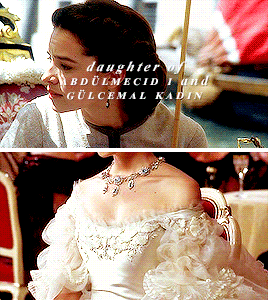




(OTTOMAN) WOMEN’S HISTORY MEME | 5 princesses: Refia Sultan, daughter of Abdülmecid I
In addition to all this benevolence and generosity, Refia Sultan also appears before us for her extravagance. The princess was a person who loved luxury. In the 19th century and especially during the reign of Sultan Abdülmecid, it was almost a tradition for the women of the palace to spend more than their income. Refia Sultan was also raised in this period and was influenced by the passion for shopping and fashion of the other women in the palace. In fact, this was the result and necessity of a new lifestyle similar to those in the West. As a matter of fact, Refia Sultan ordered her carriage and harnesses from Paris, and ordered her clothing needs from the famous French shops of Beyoğlu. French brands were preferred for shopping under the influence of the French style. Refia Sultan had Abdullah Fréres and Vasilaki Kargopoulo, who were the official photographers of the palace and the sultan at that time, take pictures; she has had large and small charcoal and painted pictures made. The princess paid considerable sums for these as well. — Arif Kolay, Osmanlı Saray Hayatından Bir Kesit: Ali Akyıldız ve Mümin ve Müsrif Bir Padişah Kızı Refia Sultan
240 notes
·
View notes
Photo







𝐢𝐧 𝐭𝐡𝐞 𝐦𝐨𝐧𝐭𝐡 𝐨𝐟 𝐅𝐞𝐛𝐫𝐮𝐚𝐫𝐲 𝐢𝐧 𝐎𝐭𝐭𝐨𝐦𝐚𝐧 𝐡𝐢𝐬𝐭𝐨𝐫𝐲
#history#historyedit#ottoman history#ottomanladiesedit#*everymonth#husnusah kadin#mehmed vi#murad ii#mahidevran hatun#fatma neslisah sultan daughter of sehzade omer faruk#saliha naciye hanim#saliha sultan daughter of mahmud ii#pertevniyal sultan#mustafa ii#bedrifelek kadin#osman ii#refia sultan daughter of abdulmecid i#murad iv#abdulhamid ii#ummugulsum sultan daughter of ahmed iii#sayeste hanim#adile sultan daughter of mahmud ii#nazima sultan daughter of abdulaziz#abdulaziz#elaru mevhibe kadin#sehzade cem son of mehmed ii#ahmed ii#cemile sultan daughter of abdulmecid i#meleki kalfa
132 notes
·
View notes
Photo





𝐢𝐧 𝐭𝐡𝐞 𝐦𝐨𝐧𝐭𝐡 𝐨𝐟 𝐉𝐚𝐧𝐮𝐚𝐫𝐲 𝐢𝐧 𝐎𝐭𝐭𝐨𝐦𝐚𝐧 𝐡𝐢𝐬𝐭𝐨𝐫𝐲
#history#historyedit#ottoman history#*everymonth#ottomanladiesedit#mihrimah sultan#safiye sultan#mehmed iv#bidar kadin#saliha dilasub sultan#sayan kadin#bedrifelek kadin#refia sultan daughter of abdulmecid i#osman iii#sehzade mehmed son of ahmed i#haseki rabia sultan#murad iii#mustafa i#zekiye sultan daughter of abdulhamid ii#fatma ulviye sultan daughter of mehmed vi#durrusehvar sultan daughter of abdulmecid ii#mustafa iii
141 notes
·
View notes
Note
I have a lot of interest rest in Ottomans. How fashion changed after 1860s in Ottoman women? Ottoman fashion which is shown in Payitaht Abdulhamid in 1890s, was it real? Please explain with pictures
I am sorry for the long wait, I had internet connection problems.
After 1860s is a very specific time but I'll do my best. We can't forget that talking about fashion in a setting like the Ottoman empire is way more difficult because women weren't supposed to be portrayed or photographed so the material is scarce.
It was after the visit of the Empress Eugénie that the women of the palace and the wives of the high functionaries copied as nearly as they could the appearance of the beautiful Empress. They divided their hair in the middle, and spent hours in making little bunches of curls. High-heeled shoes replaced the coloured babouches [slippers]; they even adopted the hideous crinolines and abandoned forever those charming Oriental garments, the chalvar and the entari which they considered symbols of servitude, but which no other fashion has been able to equal in beauty — Zeynoub Hanoum, A Turkish Woman’s European Impressions
The chalvar, called şalvar in Turkish are the characteristic baggy pants that women (and men too) would wear underneath their several layers of clothing. The entari was worn over the undergarments and the şalvar:

These are all XIX century entari.
In any case, rich women began to abandon these clothes for more European ones especially after the visit of Empress Eugénie in Istanbul. This can be seen clearly in children's fashion:

Nazima Sultan in 1876 and Naime Sultan in 1882
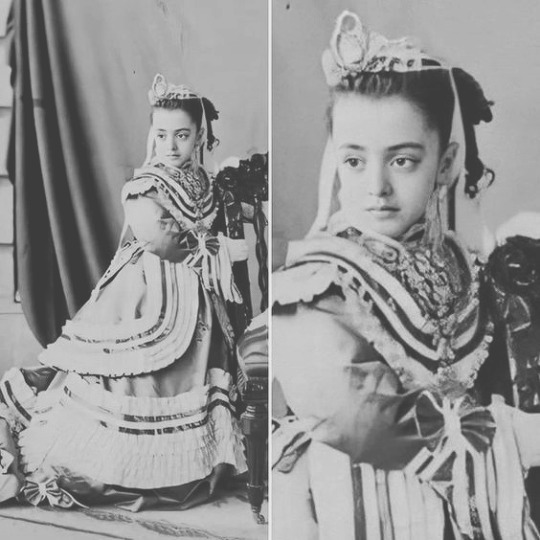
Saliha Sultan in the 1870s
In this period [1867], the young ladies and young girls had completely abandoned the old dresses with three tails or trains and the baggy pants underneath; fashion now demanded shirts with a single train which was caught up and attached to the belt – there were now petticoats instead of şalvars or the baggy pants previously worn. The headdresses had also changed with the times and now usually matched the costumes; there were earrings with jewels, medallions and elaborate hairstyles, garnished with precious stones. — Leyla (Saz) Hanımefendi, The Imperial Harem of the Sultans. Daily Life at the Çıragan Palace During the Nineteenth Century
As for outerwear:
Women changed the thicker cloth they had traditionally used for their feraces (long flowing outer garments) for a much thinner material. They changed their yellow boots of morocco leather for shoes with trimmings of imitation gold thread, which they wore with thin, white socks. They began to use thinner veils and they turned covering themselves into a method for making themselves more alluring, a trend appreciated by Ali Rıza Bey, who commented that ‘the veils of our women, which were a means of ornamenting the face rather than concealing it, became finer. How charming the colourful feraces looked! And these finer veils were unable to obscure the beauty [behind]’. — Ebru Boyar, Kate Fleet - A Social History of Ottoman Istanbul
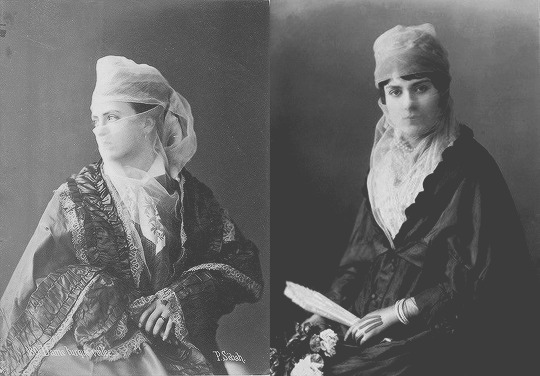
These photographs are great examples of just how fine veils had become. They basically did not hide any feature and this was a problem for conservatives (and sultans as well):
The çarşafs had become merely ordinary dresses, the feraces had turned into sleeveless capes, the veils had become too thin. [Abdülhamid II] issued an order that this should not occur. Further, women were not to wear coats or short, tight-waisted jackets which imitated military styles — Ebru Boyar, Kate Fleet - A Social History of Ottoman Istanbul

In the photograph above you can see a western dress underneath the ferace and several rows of what seem to be pearls.
In the XIX century, women (especially wealthy women of course) began to go out more, especially to pleasure gardens or at the Bosphorus shore. This meant that new accessories began to be used, among them the parasol. As pleasure gardens (ie. parks) were public places, men and women could see each other in these occasions:
A parasol in the rowing boat! It explains what the person wants to say. For example, if it is bent a little to one side, it means ‘I am annoyed with you’, if it is bent over further, ‘I am really angry’, if it completely covers the face, it means ‘you will not see my face again’, ‘I don’t want to see you, have you still not understood?’, if it swings hard from right to left, it signifies ‘don’t stay, pass by’, ‘return, go’, if it falls slightly to the front, it is in the place of a greeting, ‘welcome, sir’, if it falls a lot, ‘my heart has beaten again’, if it goes to the back, it means ‘oh!’, if it leans all the way over backwards, ‘what a state I am in, see me and have pity!’, if it is held to the side, ‘oh, how fine, what happiness this is!’, if it is opened and closed, it means ‘not tonight, tomorrow’, if it is closed and stays so, ‘we will make an appointment for the following day — Ebru Boyar, Kate Fleet - A Social History of Ottoman Istanbul
Men too had secret gestures:
making signs with the eyes and eyebrows, winking one eye, making as if wiping your face with a handkerchief, smelling the handkerchief with which you have just wiped your face, sighing deeply, and placing your hand over your heart. Placing your hand on your temple and half-closing then closing your eyes means ‘I am dying for you’, unbuttoning of one or two buttons of the waistcoat means ‘my heart is palpitating, I cannot bear this beating’. If you have a cigarette in your mouth, even if it is newly lit, and you take it from the corner of your mouth and hurl it away, this is because women do not like addiction to tobacco any more than its smell. To call over a beggar and give him a few coins demonstrates your compassion and generosity. To be busy looking at the posters outside Manakyan’s theatre is a sign of liking romantic themes such as La Dame aux camelias or Countess Sara. — Sermet Muhtar Alus, 30 Sene Evvel İstanbul. 1900’lü Yılların Başlarında Şehir Hayatı
... clothing made in European fashion, top hats, fancy canes, pet dogs, piano lessons, French language lessons, operas, dances, and balls, to the eventual employment of Western literary forms such as the novel, short story, and newspaper and the print culture it introduced, which had profound effects in creating new visions of Ottoman society and the individuals living within it. These literary forms constructed a new image of an Ottoman as a refined man "introverted, very sensitive, knowledgeable in Western music and literature, conversant in a Western language, positivist, attributing value to human beings, and subscribing to a Western style of life" — Fatma Müge Göçek, Rise of the Bourgeoisie, Demise of Empire; Ottoman Westernization and Social Change
Of course the same craze invested the Palace. Sisters Fatma and Mediha are clearly wearing European gowns and accessories:

Fatma Sultan around 1870 and Mediha Sultan in 1888
In the photograph below we can see Refia Sultan dressed exactly like a European woman in 1865. 1865 is very early but she was very interested in everything that came from Europe.

I was not able to identify these people but they're clearly from the Ottoman empire:

the lady is particularly interesting because not only is she wearing a European-style tiara but she seems to be also wearing the Order of the Charity (the white sash) 1st class, which was usually awarded to princesses.
Here we have sisters Hatice, Fehime and Fatma (all daughters of Murad V). The European style of their clothes and accessories is pretty evident.
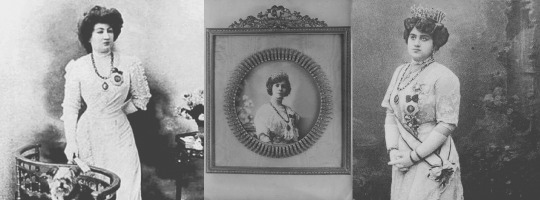

Rukiye Sabiha Sultan on her wedding day in 1921
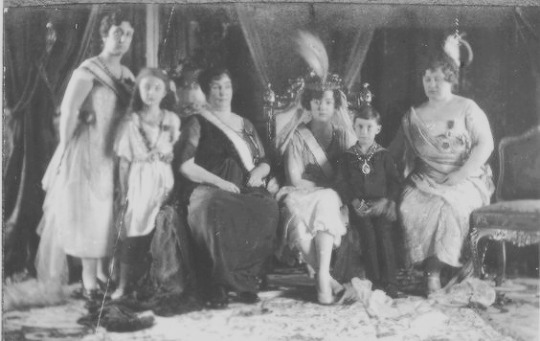
other photo of Rukiye Sabiha Sultan’s wedding
So... yeah, by the fall of the empire clothes were completely European.
#anon#ask post#ask: ottoman history#ottoman fashion#ottoman photos#late ottoman empire#nazima sultan daughter of abdulaziz#naime sultan daughter of abdulhamid ii#saliha sultan daughter of abdulaziz#fatma sultan daughter of abdulmecid i#mediha sultan daughter of abdulmecid i#refia sultan daughter of abdulmecid i#hatice sultan daughter of murad v#fehime sultan daughter of murad v#fatma sultan daughter of murad v#rukiye sabiha sultan daughter of mehmed vi
189 notes
·
View notes
Note
is their any document/letter between valide sultan and other princesses(except her girls)? I am quite curious how they addressed each other! Is there any way to know? :)
I don't know if we have any surviving letter but I'm pretty sure that they used their titles to address each other: Sultan Efendi Hazretleri (Your Highness Madam Princess) and Valide Sultan Efendi Hazretleri (Your Majesty Madam Valide Sultan).
The harem was a very formal place.
EDIT: Seniha Sultan used to write to her half-sister Behice, and this is how she addressed her in letters:
Devletlü İffetlü Hemşire-i Muhteremem Efendim Hazretleri
Your Excellency, Your Highness honourable and chaste sister Madam
Note that Seniha was younger than Behice, hence the very formal greeting. Refia Sultan, who was older, started her letter with “My dear sister”
#anon#ask post#ask: ottoman history#ottoman harem#seniha sultan daughter of abdulmecid i#behice sultan daughter of abdulmecid i#refia sultan daughter of abdulmecid i
17 notes
·
View notes
Photo


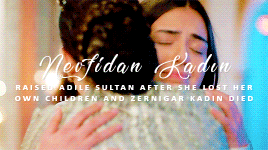

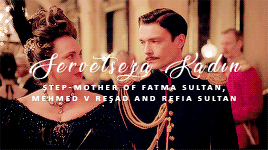
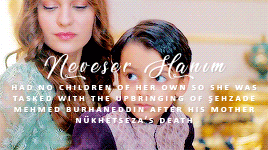
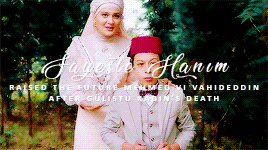

OTTOMANLADIES’ 2ND BIRTHDAY CELEBRATIONS
ottoman consorts who took other women’s children into their care – requested by anon
#history#historyedit#ottoman history#kosem sultan#turhan hatice sultan#nevfidan kadin#verdicenan kadin#sayeste hanim#rahime perestu sultan#neveser hanim#servetseza kadin#ottomanladiesedit#*requested#adile sultan daughter of mahmud ii#abdulhamid ii#cemile sultan daughter of abdulmecid i#mehmed v#fatma sultan daughter of abdulmecid i#refia sultan daughter of abdulmecid i#mehmed vi#mediha sultan daughter of abdulmecid i
524 notes
·
View notes
Note
Hello, Can you list the granddaughters of Abdülmecid I.
Murad V
Hatice Sultan (4.5.1870-13.3.1938)
Fehime Sultan (2.7.1875-15.9.1929)
Fatma Sultan (19.6.1879-20.11.1932)
Aliye Sultan (24.8.1880-17.09.1903)
Fatma Sultan
Cemile Hanım-Sultân (1855-1855)
Emîne Lutfiye Hanım-Sultân (2.1863-8.1865)
Refia Sultan
unnamed princess (?-after 1886)
Abdülhamid II
Ulviye Sultan (1868-5.10.1875)
Zekiye Sultan (21.1.1872-13.7.1950)
Fatma Naime Sultan (4.9.1875-1945)
Naile Sultan (9.1.1884-25.10.1957)
Seniye Sultan (1884-1884)
Seniha Sultan (1885-1885)
Şadiye Sultan (30.11.1886-20.11.1977)
Ayşe Sultan (31.10.1887-11.8.1960)
Refia Sultan (15.6.1891-1938)
Hatice Sultan (10.7.1897-13.2.1898)
Aliye Sultan (1900-1900)
Cemile Sultan (1900-1900)
Samiye Sultan (16.1.1908-24.1.1909)
Cemile Sultan
Fethiye Hanım-Sultân (1859 - 22.3.1887)
Ayşe Şıdıka Hanım-Sultân (21.9.1875-1937)
Fatma Hanım-Sultân (1879 - 24.2.1890)
Mehmed V
Refia Sultan (1888-1888)
Şehzade Ahmed Kemaleddin
Atiyetullah Sultan (1878-1878)
Münire Sultan (17.5.1880-7.10.1939)
Şehzade Selim Suleyman
Emine Naciye Sultan (25.11.1896-5-12-1957)
Mehmed VI
Münire Sultan (1888-1888)
Fatma Ulviye Sultan (11.9.1892-25.1.1967)
Rukiye Sabiha Sultan (2.4.1894-26.8.1971)
Şehzade Mehmed Burhaneddin
unnamed princess (1876?-1890?)
#anon#ask post#ask: ottoman history#abdulmecid i#hatice sultan daughter of murad v#fehime sultan daughter of murad v#fatma sultan daughter of murad v#aliye sultan daughter of murad v#fatma sultan daughter of abdulmecid i#refia sultan daughter of abdulmecid i#ulviye sultan daughter of abdulhamid ii#zekiye sultan daughter of abdulhamid ii#naime sultan daughter of abdulhamid ii#naile sultan daughter of abdulhamid ii#sadiye sultan daughter of abdulhamid ii#ayse sultan daughter of abdulhamid ii#refia sultan daughter of abdulhamid ii#cemile sultan daughter of abdulmecid i#refia sultan daughter of mehmed v#sehzade ahmed kemaleddin son of abdulmecid i#sehzade selim suleyman son of abdulmecid i#munire sultan daughter of mehmed vi#fatma ulviye sultan daughter of mehmed vi#rukiye sabiha sultan daughter of mehmed vi#sehzade mehmed burhaneddin son of abdulmecid i#Anonymous
6 notes
·
View notes
Note
Hey I love your blog!! I wanted to ask if there were any sultanas who maybe adopted children to raise them or sultanas who had good relationships with the Sultan’s children from other concubines? I recall you mentioning Nurbanu had adopted a boy and that Turhan protected Ibrahim’s other sons with her life for as long as she lived
Sure! There’s plenty of them, especially after the practice of fratricide died out:
Kösem had a good relationship with Osman II, and would take him on carriage rides with her sons
Rahime Perestu raised Abdülhamid II and his half-sister Cemile when their mothers died. Abdülhamid II also had a warm relationship with Pertevniyal Valide Sultan; on the contrary, he couldn’t stand Şevkefza Valide Sultan
Abdülaziz was in such good relationship with Tiryâl Hanım, one of his father’s consorts, that during his reign she was referred to as “the second valide sultan”
Servetseza Kadın loved Murad V like a son, and was also step-mother of Mehmed V, Refia and Fatma Sultan
Neveser Hanım raised Şehzade Mehmed Burhaneddin, son of Abdülmecid I and Nükhetseza Hanım
Şayeste Hanım raised Mehmed VI when his mother died
Mehmed II called Mara Brankovic “mother”, suggesting a close relationship between the two
the Venetian ambassador once saw Handan with little Mustafa I in the gardens of Topkapi Palace... maybe she ensured that he was well looked after
#anon#ask post#ask: ottoman history#kosem sultan#osman ii#rahime perestu sultan#abdulhamid ii#pertevniyal sultan#sevkefza sultan#abdulaziz#tiryal hanim#servetseza kadin#murad v#mehmed v#refia sultan daughter of abdulmecid i#fatma sultan daughter of abdulmecid i#neveser hanim#sayeste hanim#mehmed ii#mara hatun#handan sultan#mustafa i
56 notes
·
View notes
Note
Can you list some information about Abdulmecid I’s children with some information about them just like you did for Ahmed III harem + children.
Sorry for the long wait but... the guy had 42 children
Mevhibe Sultan (1840-1841), with Hoşyar Kadın: lived for only 8 months, was buried in the Hamidiye Mausoleum
Sultan V. Murad Han (1840-1904), with Şevkefza Valide Sultan: 33rd Ottoman sultan, he reigned for only 93 days, after which he was deposed on the grounds of "perpetual insanity"
Naime Sultan (1840-1843), with Tirimüjgan Kadın: Abdülhamid II's elder sister, she died of smallpox
Fatma Sultan (1840-1884), with Gülcemal Kadın: Mehmed V's eldest sister and Murad V's favourite sister. She had two husbands: Dâmâd'Alî Gaalib Paşa and Dâmâd Mehmed Nûrî Paşa, which she outlived. Her three children died in infancy and she spent the last years of her life confined in her villa in Istanbul because she had tried to reinstate Murad V on the throne. She died at the age of 44 and was buried in Murad V's mausoleum.
Behiye Sultan (1841-1847), mother unknown: she died at the age of 6 and was buried in the mausoleum of Refia Sultan. Her mother was "Her Highness, the Second Ikbal"
Neyyire Sultan (1841-1843), with Şayeste Hanım: she died at the age of 3 and was buried in the Nurosmaniye Mosque.
Refia Sultan (1842-1880), with Gülcemal Kadın: Mehmed V's elder sister. She was married to Dâmâd Mahmûd Edham Paşâ and had a daughter with him. Refia was extremely educated, like her sisters, as her father had insisted for them to be educated both in traditional and western subjects. Contrary to her younger sister Cemile, whom her father constantly lauded, Refia was a true spendthrift and her debts were staggering for just one person.
Hatice Sultan (1842-1842), with Gülcemal Kadın
Sultan II. Abdülhamid Han (1842-1918), with Tirimüjgan Kadın: 34th Ottoman Sultan, he was deposed by the Young Turks in 1909 and exiled to Thessalonika. None of his sons would ascend the throne.
Aliye Sultan (1842-1845), with Şevkefza Valide Sultan: younger sister of Murad V, she was 2 when she died and was buried in the New Mosque
Mehmed Ziyaeddin Efendi (1842-1845), with Nesrin Hanım:
Cemile Sultan (1843-1915), with Düzdidil Hanım: her mother died when she was 3, so she was raised by Rahime Perestu, future Valide Sultan. She was therefore very close to her older brother Abdülhamid II, who had been raised by Rahime Perestu as well. She married Dâmâd Mahmûd Celaleddîn Paşa in 1858, when she was fifteen. Her husband was the second son of Dâmâd Ahmed Fethî Paşa (husband of Mahmud II's daughter, Atiye Sultan) from his first wife. Fındıklı Palace was built for them. Together they had 6 children: Fethiye Hanım-Sultân (1859 - 1887), Sultân-zâde Besim Beyefendi (died at the age of 2), Sultân-zâde Sâkıb Beyefendi (1864 - 1897), Sultân-zâde Mehmed Mahmûd Celâleddîn Beyefendi (1864 - 1916), 'Ayşe Şıdıka Hanım-Sultân (1875 - 1937?), Fatma Hanım-Sultân (1879 - 1890)
Sultan V. Mehmed Reşad Han (1844-1918), with Gülcemal Kadın: 35th Ottoman Sultan, he was enthroned by the Young Turks after the deposition of Abdülhamid II and was the last sultan to die in office.
Münire Sultan (1844-1862), with Verdicenan Kadın: she firstly married the son of the Egyptian Khedive, İbrahim İlhami Paşa, and the costly wedding ceremony attracted a lot of criticism because the Imperial Army had just been defeated in Montenegro. The marriage lasted only two years, as İbrahim İlhami Paşa died at only 24 years old. She therefore married Lieutenant General Dâmâd İbrahim Paşa, with whom she had a son: Sultân-zâde 'Alâeddîn Beyefendi (1861 - 1915?). She was buried in the mausoleum of her great-grandmother, Nakşıdil Valide Sultan.
Samiye Sultan (1845-1845), mother unknown: she was buried in the New Mosque. Her mother had been listed as "Her Highness, the Third Kadinefendi"
Ahmed Efendi (1846-1846), with Nükhetseza Hanım: he was buried in the New Mosque inside the mausoleum of Refia Sultan
Fatma Nazime Sultan (1847-1847), mother unknown: she was buried in the mausoleum of Refia Sultan
Sabiha Sultan (1848-1849), with Mehtab Kadın: she was buried in the mausoleum of Refia Sultan
Mehmed Abid Efendi (1848-1848), with Tirimüjgan Kadın: he was buried in the mausoleum of Refia Sultan
Ahmed Kemaleddin Efendi (1848-1905), with Verdicenan Kadın: he was a supporter of Murad V's rights to the throne and was in a bad relationship with her other older brother, Abdulhamid II. He married his only consort, Fatma Sezâ-dil Hanımefendi, in 1876, and had two daughters with her: Atiyetullah Sultan (1878-1878) and Münire Sultan (1880-1939). His daughter married Dâmâd Mehmed Sâlih Paşa in 1907 and had a son, Sultân-zâde Ahmed Kemâleddîn (Keredin) Beyefendi (1908-1987), clearly named after her father.
Atiyetullah Efendi (?-?)
Mehmed Fuad Efendi (died in infancy), with Nergizu Hanım: he was buried in the mausoleum of Refia Sultan
Behice Sultan (1848-1876), with Nesrin Hanım: she lost her mother at the age of 3 and contracted tuberculosis in childhood. She lived secluded all her life and her sisters Refia and Seniha always sent her letters to cheer her up, even though they knew that Behice's illness had reached the final stage by the time she had turned 20. In her letters, Behice came across as frustrated, jealous of her sisters' freedom and extremely sensitive. Her dowry had been prepared by her father but her illness always prevented her from getting married, even though that was her dream. Finally, her uncle Abdülaziz consented, and Behice married Dâmâd Halil Hamîd Beyefendi on 16 November 1876. Unfortunately, the princess died just 20 days later at the age of 28. She was buried in the mausoleum of Münire Sultan.
Mehmed Burhaneddin Efendi (1849-1876), with Nükhetseza Hanım: he was Abdülhamîd II's favourite brother, who also named a warship after him. He had two consorts: Mest-i Niyâz Hanımefendi and Şâd-rûy Hanımefendi. From his first consort, he had an unnamed daughter (1876? -1890?) and Ibrahim Tevfik Efendi (1874-1931). He was buried in the mausoleum of his father Abdülmecid
Rukiye Sultan (1850-1850), with Gülcemal Kadın:
Mukbile Sultan (1850-1850), mother unknown: buried in the mausoleum of Refia Sultan, her mother had been listed as "Her Highness, the Fourth Ikbal"
Mehmed Vamık Efendi (1850-1850), mother unknown: buried in the mausoleum of Refia Sultan
Nizameddin Efendi (1850-1853), with Nesrin Hanım: twin of Bahaeddin Efendi, he was buried in the mausoleum of Murad V
Bahaeddin Efendi (1850-1852), with Nesrin Hanım: twin of Nizameddin Efendi, he was buried in the mausoleum of Refia Sultan
Ahmed Nureddin Efendi (1852-1885), with Mehtab Kadın: he had two consorts, Nazlı Emşâl Hanımefendi and an unnamed one, but no children. He died at the age of 33 and was buried in the mausoleum of Murad V
Mehmed Rüşdü Efendi (1852-1852), with Ceylanyar Hanım: buried in the Hamidiye Tomb.
Osman Safiyeddin Efendi (1852-1855), with Ayşe Serfiraz Hanım: buried in the mausoleum of Abdülmecid I
Seniha Sultan (1853-1931), with Nalandil Hanım: she married Dâmâd Âsaf Mahmûd Celaleddîn Paşa (the son of Dâmâd Halil Rifat Paşa after the death of Saliha Sultan, daughter of Mahmud II) in 1877. Celaleddîn Paşa wasn't particularly trusted by Abdülhamid II but was nevertheless appointed vizier. Seniha and her husband participated in the Ali Suavi Incident, actually a conspiracy to dethrone Abdulhamid II and re-instate Murad V, the failure of which - among other things - prompted Celaleddîn Paşa to leave the Ottoman empire and settle in Bruxelles. Together, they had two sons: Sultân-zâde Mehmed Sabâhaddîn Beyefendi (1877-1948) and Sultân-zâde Ahmed Lutfullâh Beyfendi (1880-1973). Her son Sabâhaddîn was a vocal critic of Abdülhamid II's regime and was actually the leader of a faction inside the Young Turks movement which advocated some of the same liberal principles of the CUP but instead favoured administrative decentralization and European assistance. At the time of the Dynasty's exile from Turkey, Seniha Sultan was the eldest princess alive. She lived with Mehmed VI in Sanremo until his death, then moved to Nice, where the last Caliph Abdülmecid II had settled down but was not in favour because she was part of the "Mecid branch" of the family. She spent her last years bedridden in a room inside the caliph's villa and Nice and died there in 1931. She was buried in the Sultan Selim Mosque in Damascus.
Abdullah Efendi (1853-1853), with Şayeste Hanım: stillborn
Mehmed Abdüssamed Efendi (1853-1855), with Nalandil Hanım: buried in the mausoleum of his father
Zekiye Sultan (1855-1856), with Gülistu Kadın: twin of Fehime Sultan, was buried in the mausoleum of Münîre Sultân
Fehime Sultan (1855-1856), with Gülistu Kadın: twin of Fehime Sultan, was buried in the mausoleum of Münîre Sultân
Mediha Sultan (1856-1928), with Gülistu Kadın: elder sister of Mehmed VI, she fell in love with the son of Sâmi Paşa and started corresponding with him. When Abdülhamid II found out, he sent Necib Bey at the embassy in Paris. Mediha was devastated: she would not drink, eat or sleep. Her step-mother Verdicenan asked Rahime Perestu Valide Sultan's help, and together they were able to convince Abdülhamid to let the princess marry Necib Bey, which she did in 1879. Mediha had a son with him, Sultân-zâde 'Abdurrahmân Sâmî Beyefendi (1880-1961), but her happiness was short-lived: her husband died in 1885 at the age of 29. In 1886, she married her second husband, Dâmâd Mehmed Ferîd Paşa, but had no children with him.
Naile Sultan (1856-1882), with Şayeste Hanım: she married Dâmâd Çerkes Kabasakâl Mehmed Paşa who, according to Ayşe Osmanoğlu, was a brother of Abdülhamid II's consort Bidar Kadın. They had no children. She was buried in the mausoleum of Murad V
Bedia Sultan (1857-1858), with Ayşe Serfiraz Hanım: she was buried in the mausoleum of Münîre Sultân.
Selim Süleyman Efendi (1860-1909), with Ayşe Serfiraz Hanım: he had 5 consorts: Filiz-san Hanımefendi, Emîne Câvidân Hanımefendi, Fatma ikbâl Hanımefendi, 'Ayşe Tarz-ı ter (Tarz-ender) Hanımefendi and Zât-ı Melek Hanımefendi. His children were: Mehmed 'Abdülhalîm Efendi (1894-1926), Emine Naciye Sultan (1896-1961), and Damad Mehmed Şerefeddin Efendi (1904-1966)
Sultan VI. Mehmed Vahideddin Han (1861-1926), with Gülistu Kadın: last sultan of the Ottoman Empire, he was deposed in 1922 when the Republic of Turkey was proclaimed and exiled in 1924. He died in Sanremo, Italy
#anon#ask post#ask: ottoman history#abdulmecid i#murad v#abdulhamid ii#mehmed v#mehmed vi#fatma sultan daughter of abdulmecid i#refia sultan daughter of abdulmecid i#cemile sultan daughter of abdulmecid i#munire sultan daughter of abdulmecid i#sehzade ahmed kemaleddin son of abdulmecid i#behice sultan daughter of abdulmecid i#sehzade mehmed burhaneddin son of abdulmecid i#seniha sultan daughter of abdulmecid i#mediha sultan daughter of abdulmecid i#naile sultan daughter of abdulmecid i#sehzade selim suleyman son of abdulmecid i
21 notes
·
View notes
Photo
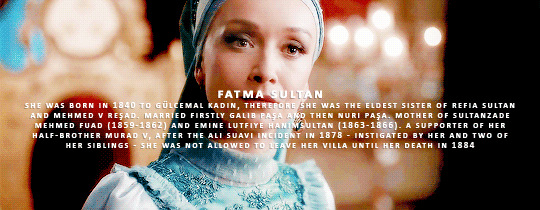

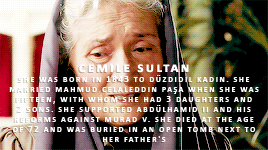
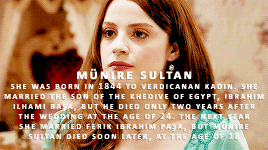

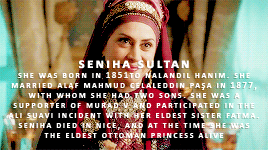
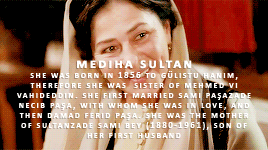
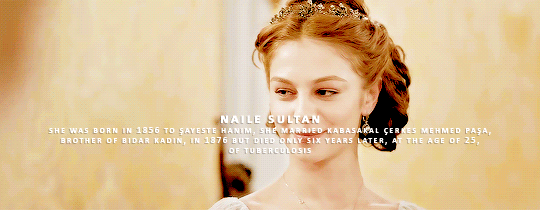
Abdülmecid I of the Ottoman Empire + daughters who survived infancy
#history#historyedit#ottoman history#abdulmecid#fatma sultan daughter of abdulmecid i#refia sultan daughter of abdulmecid i#cemile sultan daughter of abdulmecid i#munire sultan daughter of abdulmecid i#behice sultan daughter of abdulmecid i#seniha sultan daughter of abdulmecid i#mediha sultan daughter of abdulmecid i#naile sultan daughter of abdulmecid i#ottomanladiesedit#daughtersof#so... yeah... i thought they were seven....#i don't know how to count yep#late ottoman empire
878 notes
·
View notes
Note
What kind of women were most wanted in harem? Blonde or brunettes?
I have already answered this but blondes with blue eyes were generally the most sought after, because they were considered the most beautiful at the time. It also depended on the sultan’s personal taste though: we know that Murad V liked blondes in general, but of course that doesn’t mean that he completely ignored non-blonde women.
...at the holidays, when a prince came round to pay his respects to the princesses, he was not served by just any girl. Considerable thought was put into the matter in advance, and one girl was selected to serve him. If it became clear that the visiting prince took a fancy to the girl, she was instantly presented to him as a lady for his harem. She would be sent over to his palace after he left. Conforming to this custom, Princess Refia, who knew that her brother liked blondes, selected a tall, yellow-haired girl and for a period of time had her provided with special training.
[...]
When after dinner the orchestra struck up European music and dancing began, the Heir summoned Meyliservet and danced with her. During this dance he displayed an obvious interest in her. When Princess Refi a noticed what was happening, she was reluctant to tell her brother that she had groomed the blonde girl for him, so she pulled her other brother Prince Kemaleddin aside and asked him to do so. Prince Kemaleddin approached Prince Murad on some pretext and relayed to him what their sister had said, but he received this reply from Prince Murad: “I don’t care for that blonde girl. I’d like our sister to give me the girl I danced with.” Of course Princess Refia could not refuse her brother’s wish, and so she sent Meyliservet forthwith to the apartments of the Heir. After some time Meyliservet became pregnant and gave birth to Princess Fehime.
-- Douglas Scott Brookes, The Concubine, the Princess, and the Teacher
#anon#ask post#ask: ottoman history#ottoman harem#murad v#refia sultan daughter of abdulmecid i#meyliservet kadin
25 notes
·
View notes
Note
Hello,could you list some of Mahmud ll’s granddaughters.
Hello! I have listed all the granddaughters in case someone else wants to know about more of them.
by Saliha Sultan:
Ayşe Sıdıka Hanımsultan (1821 – 1886), who married Server Paşa, son of Saîd Server Efendi.
by Atiye Sultan:
Seniyye Hanımsultan (3.10.1843 – 10.12.1910), who married Hüseyin Hüsnî Paşa, son of Sırkâtibizâde Mustafa Paşa.
Feride Hanımsultan (30.5.1847 – 1.1913), who married Mahmûd Nedîm Paşa and, with him, had Mehmed Sâib Bey (1861 – 28.11.1871)
by Adile Sultan:
Sıdıka Hanımsultan, died in infancy
Aliyye Hanımsultan, died in infancy
Hayriye Hanım-Sultân (6.1846 – 26.7.1869), who married Ahmed Rifat Bey later Paşa
by Sultan Abdülmecid:
Mevhibe Sultan (9/31.5.1840 - 3.11.1840/9.2.1841), daughter of Huşyar Kadınefendi
Naime Sultan (11.10.1840 - 1.5.1843), daughter of Tirimüjgan Kadınefendi and thus full sister of Abdülhamid II.
Fatma Sultan (1.11.1840 - 26.8.1884), daughter of Gülcemal Kadınefendi and thus full sister of Refia Sultan and Sultan Mehmed V Reşad. She firstly married Galib Paşa, who drowned at sea, and secondly Mehmed Nuri Paşa, with whom she had: Mehmed Fuad (1859-1862) and Emine Lutfiye Hanımsultan (1863-1866)
Behiye Sultan (22.2.1841 - 3.6.1847) her mother is listed as the Second Ikbal but no name was given.
Neyyire Sultan (13.10.1841 - 14.1.1844)
Hatice (?) Refia Sultan (7.2.1842 - 4.1.1880), daughter of Gülcemal Kadınefendi, she married Mahmud Edhem Bey (son of the above mentioned Adile Sultan's husband Mehmed Ali Paşa, from a previous wife)
Aliyye Sultan (20.10.1842 - 23.7.1844/10.7.1845), possibly daughter of Şevkefza, later Valide Sultan, and thus full sister of Murad V
Cemile Sultan (17.8.1843 - 26.2.1915), daughter of Düzdidil Kadınefendi, she married Mahmud Celaleddin Bey later Paşa with whom she had: Fethiye Hanımsultan (1887-1915), Fatıma Hanımsultan (1890-1901), Sakıp Bey (1897-1930), Mehmed Celaleddin Bey (maybe twin of Sakıp Bey, 1897-1916)
Münire Sultan (9.12.1844 - 29.6.1862), daughter of Verdicanan Kadınefendi, she married firstly İbrahim İlhami Paşa and secondly Ferik (lieutenant general) İbrahim Paşa
Samiye Sultan (23.2.1845 - 15.4.1845)
Nazime Sultan (26.11.1847 - 1.12.1847)
Sabiha Sultan (15.4.1848 - 27.4.1849), daughter of Mahitab Hanım
Behice Sultan (26.8.1848 - 30.11.1876), daughter of Nesrin Hamın, she married Halil Hamid Paşazade Hamid Bey but died only 14 days after the wedding.
Mukbile Sultan (9.2.1850 - 25.2.1850), daughter of the Fourth Ikbal, no name was given.
Seniha Sultan (5.12.1851 - 15.9.1931), daughter of Nalandil Hanım, she married Mahmud Celaleddin Paşa, with whom she had: "Prince" Sabahaddin Bey (1877-1948) and Sultanzade Lütfullah Bey (1880-1973). Sabahaddin Bey was called "the Prince" in Europe.
Zekiye Sultan (26.1.1855 - 19.2.1856), twin sister of Fehime Sultan
Fehime Sultan (26.1.1855 - 10.11.1856), twin sister of Zekiye Sultan
Şehime Sultan (1.3.1855 - 21.5.1857), daughter of Senior Ikbal Nalandil.
Mediha Sultan (30.7.1856 - 7/9.11.1928), daughter of Gülistu Hamın and thus full sister of Mehmed VI Vahideddin. She married firstly Sami Paşa-zade Necip Bey later Paşa and secondly Damat Ferid Paşa.
Naile Sultan (30.9.1856 - 7/18.1.1882), daughter of Şayeste Hanım, she married Kabasakal Çerkes Mehmed Paşa but died at the age of 25.
Bedia/Bedihe Sultan (30.9.1857 - 12.7.1858), daughter of Serfiraz Hanım
By Sultan Abdülaziz:
Saliha Sultan (10.8.1862 - 1941?), daughter of Dürrinev Başkadınefendi and younger sister of Şehzade Yusuf İzzeddin Efendi. "She was engaged to a son of Khedive Ismail of Egypt, but the engagement was broken off after her father’s deposal and in April 1889 she married Ahmed Zülküfil Paşa". Her only child was Kâmile Hanım Sultan, who died in 1896.
Nazima Sultan (26.2.1866 - 26.11.1895), daughter of Hayranıdil Kadın, she married Ali Halid Paşa in 1889. She died at the age of 29.
Emine Sultan (1.12.1866 - 22.1.1867), daughter of Edadil Kadın
Esma Sultan (21.3.1873 - 8.5.1899), daughter of Gevheri Hanım, she married Çerkes Mehmed Paşa (former husband of her cousin Naile Sultan) and with him had: Sultanzade Hayreddin Bey (1889), Sultanzade Saadeddin Bey (1895), Sultanzade Hasan Bedreddin(?) and Mihriban Hanımsultan(?). She died in childbirth.
Fatma Sultan (1874): was born and died in the same year.
Emine Sultan (24.8.1874 - 30.1.1920), daughter of Nesrin Kadın. Abdülhamid II had proposed her marriage to his eldest son Abdülkadir Efendi but she did not like the prospect, so in the end she married Çavdaroğlu Ahmed Şükrü Paşa in 1901
#anon#ask post#ask: ottoman history#mahmud ii#saliha sultan daughter of mahmud ii#atiye sultan daughter of mahmud ii#adile sultan daughter of mahmud ii#abdulmecid i#fatma sultan daughter of abdulmecid i#refia sultan daughter of abdulmecid i#cemile sultan daughter of abdulmecid i#munire sultan daughter of abdulmecid i#seniha sultan daughter of abdulmecid i#mediha sultan daughter of abdulmecid i#naile sultan daughter of abdulmecid i#abdulaziz#saliha sultan daughter of abdulaziz#nazima sultan daughter of abdulaziz#esma sultan daughter of abdulaziz#emine sultan daughter of abdulaziz
12 notes
·
View notes
Note
Murad V harem + children
Sorry for the late reply!!
Consorts
Elaru Mevhibe BaşKadınefendi (6.8.1835 - 21.2.1936): Senior Consort of Murad V, she was born in Tiflis, Georgia. She entered in the Ottoman palace at a young age and was allowed to grow up among the sultan's daughters. On 2 January 1857, she married Prince Murad inside Dolmabahçe Palace, but the marriage produced no children. Elaru was Senior Consort for 93 days, after which she was confined inside Çırağan Palace with her husband and the rest of his family. She was the one who kept a correspondence with the outside throughout the confinement, asking Abdülhamid II for simple stuff, from tobacco to fruit. After the death of Murad V - which she herself announced to the sultan through a letter - she settled down in Sisli, rarely going out. When the British occupied Istanbul, she decided not to leave her home ever again and spent her last years tending to her garden. At the time of her death on 21 February 1936, she was one of the oldest living imperial consorts.
Reftar-ı dil Kadınefendi (1838 - 3.3.1936): Second Imperial Consort, she was Circassian and a member of the Hatko family. She married Prince Murad on 4 February 1859 and two years later she gave birth to his only son, Prince Selaheddin Efendi. After Murad V's death she settled in her son's palace, then she bought a house in Ortaköy in 1910. Though she fell on hard times, those who knew her said that she was always smiling. Reftaridil loved music and reading to others; she was also very knowledgeable. In 1936, she took the surname Hatgil.
Şayan Kadınefendi (4.1.1853 - 15.3.1945): Third Imperial Consort, she was born Princess Safiye Zan in Anapa. At the age of 16, she married Prince Murad at Dolmabahçe Palace. Her only child, Hatice Sultan, was born in 1870, a year after the wedding. In his memoirs, Şehzade Ali Vasıb Efendi disclosed that he used to call her "third grandma". Princess Leyla Açba met Şayan during a dinner hosted by Caliph Abdulmecid II and said that she was especially fascinated by her because "despite her old age, she spoke remarkably and was extremely kind to everyone". In 1915, the CUP cut her salary and she fell on hard times. When the Ottoman dynasty was exiled in 1924, she moved in with Reftar-ı dil Kadın in her house in Ortaköy. Şayan was the last of Murad V's consorts to die.
Meyl-i servet Kadınefendi (21.10.1859 - 9.12.1903): Fourth Imperial Consort, she chose palace life after visiting Refia Sultan with her sister. The princess took her in, and Murad later married her. In 1875, a year after the wedding, she gave birth to Fehime Sultan. She lived her whole life imprisoned in Çırağan Palace, as she died on 9 December 1903-- a year before her husband.
Resan Hanımefendi (28.3.1860 - 31.10.1910): of Georgian origins, she was born in Artvin as Ayşe to Ömer Bey and Fatma Hanım. She grew up in the household of Seniha Sultan, who then presented her to Murad V on his accession. In 1879, Resan gave birth to Fatma Sultan and a year later to Aliye Sultan. After the announcement of the Second Constitutional Monarchy, she requested to move to Yildiz Palace but in the end settled with her daughter Fatma. She died of tuberculosis on 31 March 1910.
Cevherriz Hanım (1863 - 1940): a gözde according to Filizten Hanim, Second Ikbal according to Harun Açba. She was born near Sochi and her farher was called Halil Bey. When the Circassians fled Russia, Cevherriz entered the Imperial harem, where she grew up. As she spoke French fluently, she taught it to her step-children. In 1914 she remarried, to Hüsnü Bey. Her second marriage was apparently very sad, and she passed away in Istanbul in 1940.
Nevdürr Hanım (1861 - 1927): she was born in 1861 in Batumi, the daughter of Nakaşvili Rüstem Bey. She married Murad V in 1880 and had no children with him. After the death of her husband, she was sent to Bursa with Cevherriz, Rems-şinaz and Filizten Hanım for a few years. Afterwards she went to live with her step-daughter Hatice Sultan who requested a salary for Nevdürr many times, but it was never accorded. When Hatice Sultan was exiled in 1924, Nevdürr fell in total poverty. She died in 1927 in the Beşiktaş district in Istanbul.
Rems-şinaz Hanım (1864 - after 1934): daughter of Bıjeduğ Hasan Bey, she was Circassian, and came to Istanbul after the Russian invasion of Caucasus. It is not known how she met Murad V and when she married him, probably in the 1880s. She left Çırağan Palace in the 1910 and was sent to Bursa with some of her fellow concubines, where she lived until 1914. Afterwards she returned to Istanbul and died after 1934.
Children
Mehmed Selaheddin Efendi (5.8.1861-29.4.1915): only son of Murad V to survive childhood, he lived secluded in Çırağan Palace with his own harem until the death of his father. He had 7 consorts and 14 children, but he was survived only by two sons and four daughters: Şehzade Ahmed Nihad (1883-1954), Rukiye Sultan (1885-1965), Adile Sultan (1887-1973), Emine Atiye (1891-1979), Behiye Sultan (1881-1948), Şehzade Osman Fuad (1895-1973). Mehmed Selaheddin Efendi was buried in the mausoleum of Prince Ahmed Kemaleddin.
Süleyman Efendi (1866-1866)
Hatice Sultan (5.4.1870-13.3.1938): daughter of Murad V and Şayan Kadınefendi, she married twice and had four children: Ayşe Hanımsultan (1902-?), Sultanzade Osman Bey (1910-1.1911), Sultanzade Hayri Bey (1912-195?) and Selma Hanımsultan (1911/4-1941) [more detailed life: here and here]
Seyfeddin Efendi (1872-1872)
Fehime Sultan (2.7.1875-15.9.1929): daughter of Murad V and Meyl-i servet Kadınefendi, she married twice but had no issue.
Fatma Sultan (19.6.1879-20.11.1932): daughter of Murad V and Resan Hanımefendi, she married Karacehennemzade Refik Bey and had four children with him: Ayşe Hatice Hanımsultan (1909-1968), Sultanzade Mehmed Ali Bey (1909-1981), Sultanzade Mehmed Murad Bey (1910-1911), Sultanzade Celaleddin Bey (1916-1997)
Aliye Sultan (24.8.1880-17.9.1903): younger daughter of Murad V and Resan Hanımefendi, she never married.
#anon#ask post#ask: ottoman history#*consortsandchildren#murad v#elaru mevhibe kadin#reftaridil kadin#sayan kadin#meyliservet kadin#resan hanim#cevherriz hanim#nevdur hanim#remssinaz hanim#sehzade mehmed selaheddin son of murad v#hatice sultan daughter of murad v#fehime sultan daughter of murad v#fatma sultan daughter of murad v#aliye sultan daughter of murad v
24 notes
·
View notes
Text
On this day, 23 February, in Ottoman history
23 February 1646 - Fatma Sultan marries Musahib Fazlı Paşa; Ibrahim’s daughter with - maybe - Turhan Hatice Sultan, she was widowed at 4 years old when her first husband was executed by her father. A month later, on 23 February 1646, she married her second husband, Musahib Fazlı Paşa, in a magnificent ceremony after which she was taken to his palace, accompanied by 50 bridesmaids.
23 February 1845 - birth of Samiye Sultan; daughter of Sultan Abdulmecid and his Third Imperial Consort (possibly Düzdidil Kadın), she died 2 months later in Çırağan Palace. She was buried in the New Mosque.
23 February 1875 - letter of Refia Sultan to her sister Behice; both daughters of Abdülmecid from different mothers, they kept a correspondence. They were both plagued by long illnesses, Behice Sultan suffered from tuberculosis and maybe Refia Sultan too. In this letter, Refia Sultan talked about her sister’s fiancé, Halil Hamid Paşazade Hamid Bey, whom Behice Sultan would marry in November 1876.
#history#on this day in history#on this day in ottoman history#fatma sultan daughter of ibrahim i#refia sultan daughter of abdulmecid#behice sultan daughter of abdulmecid#duzdidil kadin
18 notes
·
View notes